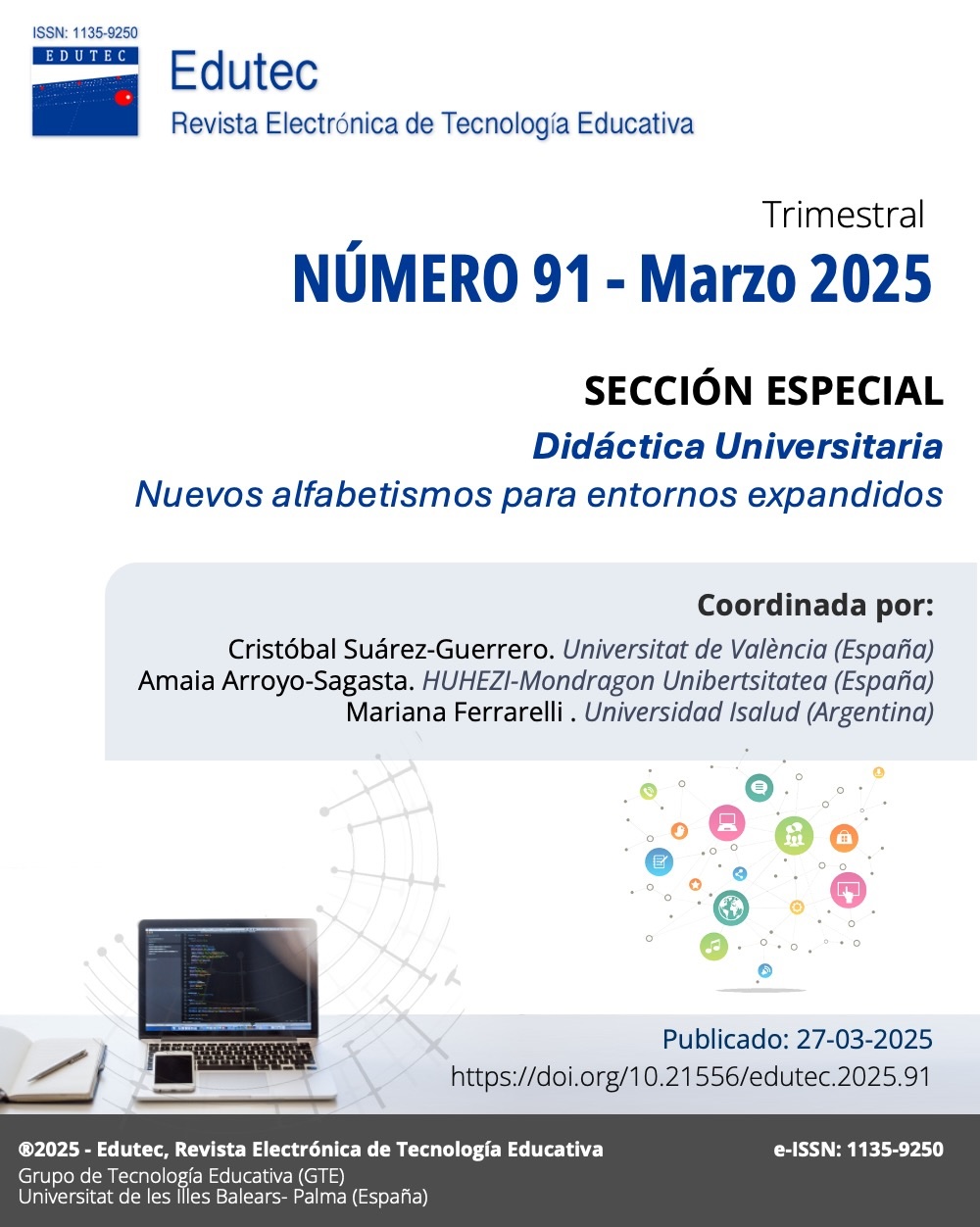Alfabetismos multimodales en la didáctica universitaria: hibridación de entornos y experiencias de aprendizaje en la era digital
DOI:
https://doi.org/10.21556/edutec.2025.91.3681Keywords:
Multimodal literacies, Hybrid learning environments, educational technology, University teaching, Technology-mediated educationAbstract
This paper examines the importance of multimodal literacies in university teaching, focusing on hybrid environments that integrate face-to-face and virtual components. The introduction emphasizes the need for both students and educators to develop skills in interpreting and producing texts in various modes (written, visual, audiovisual). Through a theoretical review of recent research on multimodality and technology in the university context, the study explores the impact of educational environment hybridization and its role in learning. The results indicate that incorporating multiple modes of communication expands learning opportunities and facilitates the implementation of new pedagogical strategies. The discussion addresses how the hybridization of environments and communicative modes enriches university teaching, promoting greater adaptation of educators to current technological demands and providing students with more comprehensive educational experiences.
Funding
Este estudio no recibió financiación para su realización.
Downloads
References
REFERENCIAS
Adell, J., y Castañeda, L. (2012). Tecnologías emergentes, ¿pedagogías emergentes? En Tendencias emergentes en educación con TIC, editado por J. Hernández, M. Pennesi, D. Sobrino, y A. Vázquez (pp. 13-32). Fundación Telefónica.
Agudo-Prado, S., Pascual-Sevillano, M. y Fombona, J. (2012). Uses of digital tools among the elderly. [Usos de las herramientas digitales entre las personas mayores]. Comunicar, 39, 193-201. https://doi.org/10.3916/C39-2012-03-10 DOI: https://doi.org/10.3916/C39-2012-03-10
Area Moreira, M. (2010). La integración de las TIC en las instituciones educativas: Modelos y escenarios educativos. Tecnología y Comunicación Educativas, 24(51), 9-23.
Area Moreira, M.; Gutiérrez Marín, A. y Vidal Fernández, F. (2012). Alfabetización digital y competencias informacionales. Fundación Telefónica.
Bozkurt, A. et al. (2020) A global outlook to the interruption of education due to COVID-19 Pandemic: Navigating in a time of uncertainty and crisis. Asian Journal of Distance Education, 15 (1) pp. 1-126.
Chocarro de Luis, E., Sobrino, A. y González-¬Torres, M.C. (2013). Scholarship of Teaching and Learning: un modelo de desarrollo profesional de los profesores universitarios. Revista Electrónica Interuniversitaria de Formación del Profesorado, 16(1), 5-¬14. http://dx.doi.org/10.6018/reifop.16.1.179401 DOI: https://doi.org/10.6018/reifop.16.1.179401
Cope, B., y Kalantzis, M. (2009). “Multiliteracies”: New Literacies, New Learning. Pedagogies: An International Journal, 4(3), 164–195. https://doi.org/10.1080/15544800903076044 DOI: https://doi.org/10.1080/15544800903076044
García-Peñalvo, F. J., Corell, A., Abella-García, V. y Grande, M. (2020). La evaluación online en la educación superior en tiempos de la COVID-19. Education in the Knowledge Society (EKS), 21, 26. https://doi.org/10.14201/eks.23086 DOI: https://doi.org/10.14201/eks.23086
Halliday, M. A. K. (1978). Language as social semiotic: The social interpretation of language and meaning. Edward Arnold.
Jewitt, C. (2013). Multimodality and literacy in school classrooms. Review of Research in Education, 37(1), 243-271.
Kress, G. (2003). Literacy in the new media age. Routledge. DOI: https://doi.org/10.4324/9780203299234
- (2010). Multimodality: A social semiotic approach to contemporary communication. Routledge.
Kress, G. y Van Leeuwen, T. (2006). Reading images: The grammar of visual design. Routledge. DOI: https://doi.org/10.4324/9780203619728
Lladó Martínez, A. (2023). El uso de la tecnología en la universidad. ¿Es necesaria su regulación? Revista de Educación y Derecho, (27). https://doi.org/10.1344/REYD2023.27.40393 DOI: https://doi.org/10.1344/REYD2023.27.40393
Martínez Alvarado, H. (2009). La integración de las TIC en instituciones educativas. En Los desafíos de las TIC para el cambio educativo, coord. por Roberto Carneiro, Juan Carlos Toscano, Tamara Díaz Fouz (págs. 61-70), Organización de Estados Iberoamericanos para la Educación, la Ciencia y la Cultura (OEI), Servicio de Publicaciones.
Monereo, C., coord., (2010). Internet y competencias básicas: Claves para su desarrollo en el aula. Graó.
Mora-Cantallops, et al. (2022). Competencias digitales del profesorado universitario en España. Un estudio basado en los marcos europeos DigCompEdu y OpenEdu. Publications Office of the European Union.
Pajares Flores, M. Y. (2014). El enfoque multimodal en la investigación científica. Investigación educativa. Revista científica de investigaciones educativas, 8, 13, pp. 63-65.
Pereles, A., Ortega-Ruipérez, B. y Lázaro, M. (2024). A digital world toolkit: enhancing teachers’ metacognitive strategies for student digital literacy development. [Herramientas para un mundo digital: mejorando estrategias metacognitivas docentes para desarrollar la alfabetización digital del alumnado]. RIED-Revista Iberoamericana de Educación a Distancia, 27(2), pp. 267-294. https://doi.org/10.5944/ried.27.2.38798 DOI: https://doi.org/10.5944/ried.27.2.38798
Vásconez Paredes, C.D. e Inga Ortega, E.M. (2021). El modelo de aprendizaje TPACK y su impacto en la innovación educativa desde un análisis bibliométrico. INNOVA Research Journal, 6(3), 79-97. https://doi.org/10.33890/innova.v6.n3.2021.1773 DOI: https://doi.org/10.33890/innova.v6.n3.2021.1773
Walsh, M. (2010). Multimodal literacy: What does it mean for classroom practice? Australian Journal of Language and Literacy, 33(3), 211-239. DOI: https://doi.org/10.1007/BF03651836
Published
How to Cite
Issue
Section
License
Copyright (c) 2025 Edutec, Revista Electrónica de Tecnología Educativa

This work is licensed under a Creative Commons Attribution 4.0 International License.
By submitting the paper, the authors assign the publication rights to the journal Edutec. For its part, Edutec authorises its distribution as long as its content is not altered and its origin is indicated. At the end of each article published in Edutec, the citation procedure is indicated.
The management and editorial board of Edutec Revista Electrónica de Tecnología Educativa do not accept any responsibility for the statements and ideas expressed by the authors in their work.
Translated with www.DeepL.com/Translator (free version)









